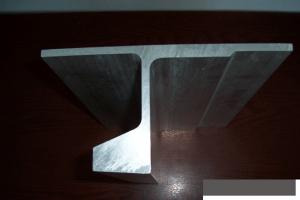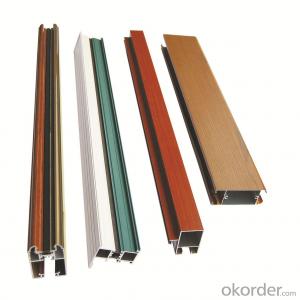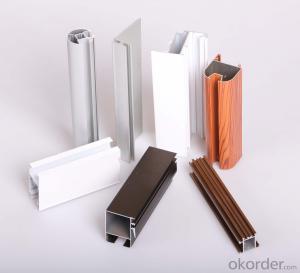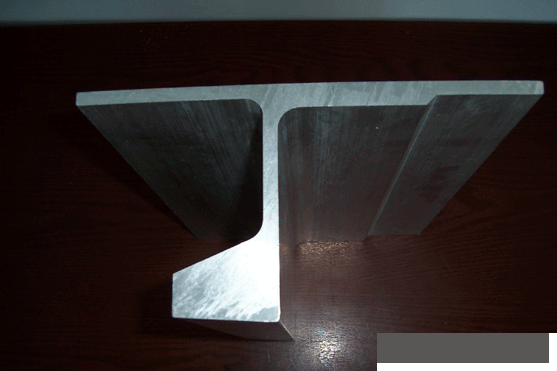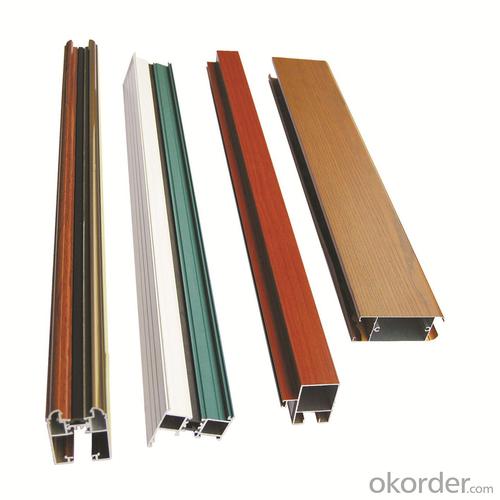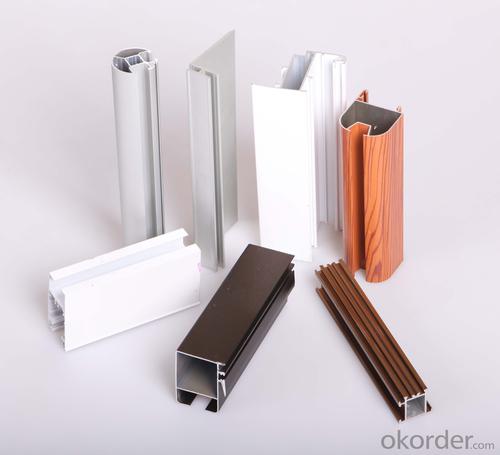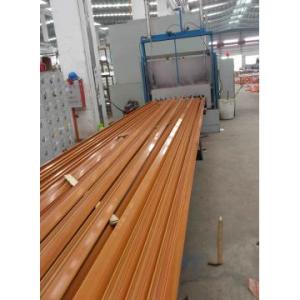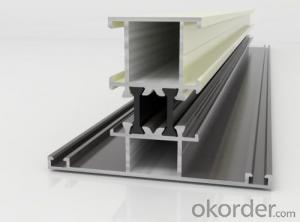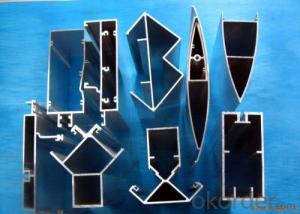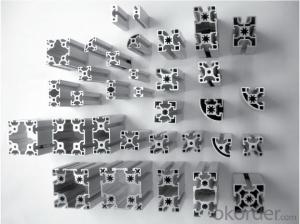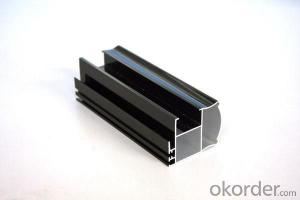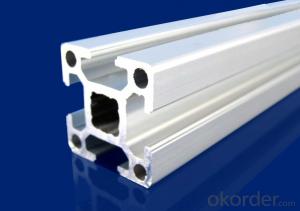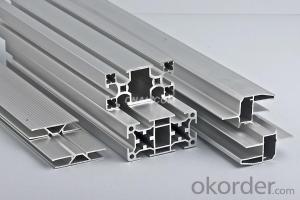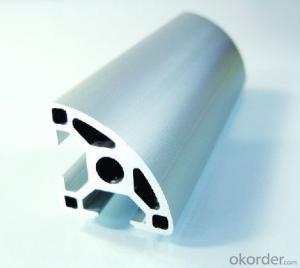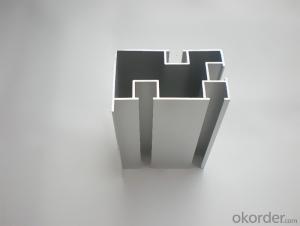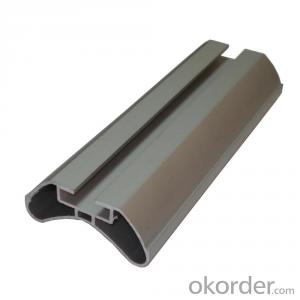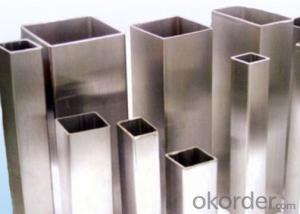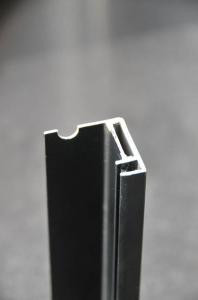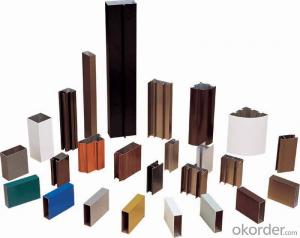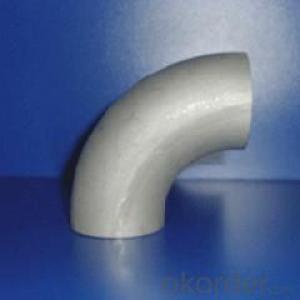Standard Aluminum Extrusion Profiles - Extruded Aluminium Profiles 6063 T6
- Loading Port:
- China Main Port
- Payment Terms:
- TT OR LC
- Min Order Qty:
- -
- Supply Capability:
- -
OKorder Service Pledge
Quality Product, Order Online Tracking, Timely Delivery
OKorder Financial Service
Credit Rating, Credit Services, Credit Purchasing
You Might Also Like
Material | Alloy 6063,6061,6005or according to customer’s choice |
Temper | T3, T4, T5, T6 |
Surface | Anodize, electrophoresis, powder coating, PVDF coating, wood grain painting, matted, etc. |
Color | Any colour based on Standard Germany RAL Mark |
Length | Coating 6.5 meters, Anodizing 6.5 meters, Mill finish 5 meters |
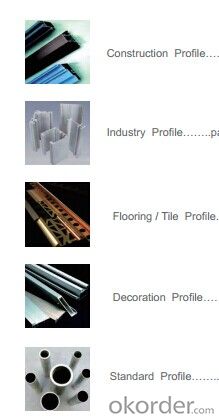
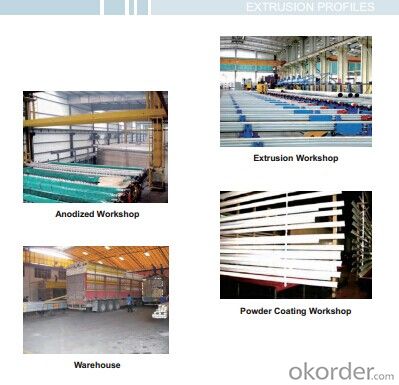
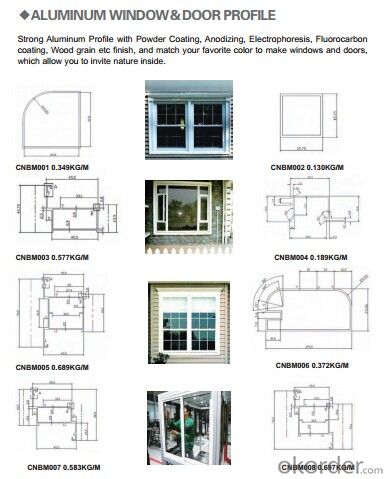
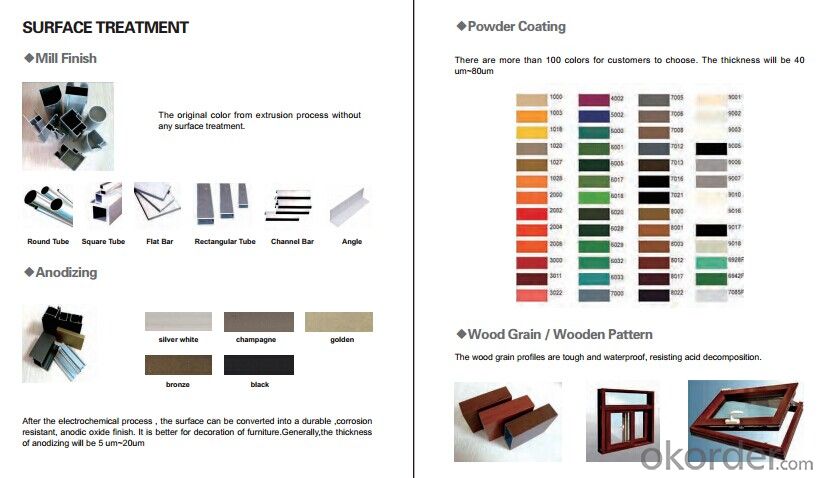
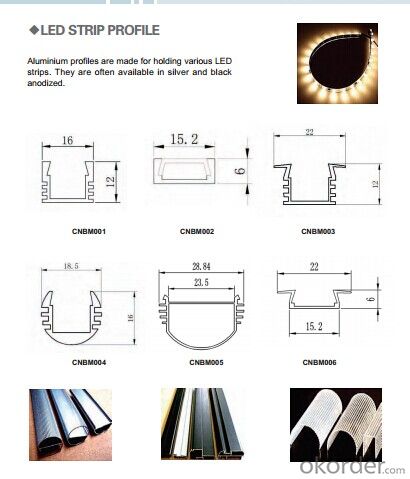
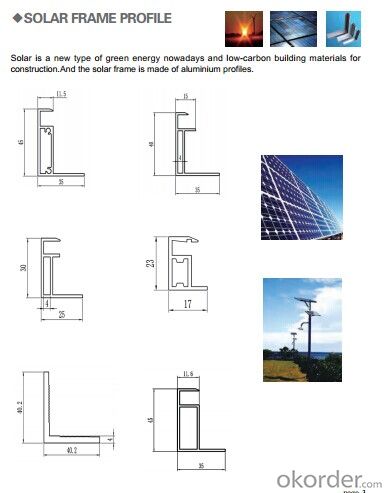
- Q: Can aluminum profiles be utilized in creating distinctive architectural structures?
- <p>Yes, aluminum profiles can be used to create unique architectural designs. They are favored for their strength, lightweight, and corrosion resistance. Architects can utilize aluminum's flexibility to design complex structures, such as intricate facades, modern window systems, and innovative support frameworks. Aluminum's adaptability allows for both functional and aesthetically pleasing designs, making it a popular choice in contemporary architecture.</p>
- Q: How do aluminum profiles perform in terms of energy efficiency?
- Aluminum profiles have excellent energy efficiency performance due to their inherent properties. They are lightweight, durable, and can be easily shaped to optimize thermal insulation. Additionally, aluminum profiles can accommodate double or triple glazing, which further enhances their energy efficiency by minimizing heat transfer and reducing energy consumption for heating or cooling.
- Q: Inquire about the various uses of aluminum profiles within the field of architecture.
- <p>Aluminum profiles have a wide range of applications in architecture due to their strength, durability, and lightweight properties. They are commonly used in curtain walls, which are the exterior coverings of buildings, providing both aesthetic appeal and structural integrity. Aluminum profiles are also utilized in window and door frames for their resistance to corrosion and ability to withstand various weather conditions. They are employed in structural glazing to hold glass in place securely. Furthermore, aluminum profiles are used in sun shading systems to control the amount of sunlight entering a building, enhancing energy efficiency. They are also found in handrails, balustrades, and other safety features for their strength and low maintenance requirements. Overall, aluminum profiles contribute to the sustainability and modern design of architectural projects.</p>
- Q: Are there any specific cleaning and maintenance instructions for aluminum profiles?
- Aluminum profiles require specific cleaning and maintenance instructions. Consider the following guidelines: 1. Ensure regular cleaning: To keep the appearance intact and prevent corrosion, it is necessary to clean aluminum profiles regularly. Utilize a mild soap or detergent mixed with water for surface cleaning. Steer clear of abrasive cleaners or steel wool, as they could potentially scratch the aluminum. 2. Steer clear of harsh chemicals: Harsh chemicals have the potential to harm the protective coating of aluminum profiles. Refrain from using strong acids, alkaline cleaners, or solvents for cleaning purposes. 3. Thorough rinsing: After cleaning, ensure that the aluminum profiles are rinsed thoroughly with clean water. This step eliminates any residue from the cleaning solution and prevents streaking. 4. Complete drying: After rinsing, dry the aluminum profiles thoroughly with a soft cloth or towel. Leaving moisture on the surface could result in corrosion, so ensuring the profiles are completely dry is crucial. 5. Lubrication: If the aluminum profiles possess moving parts or hinges, it is advisable to regularly lubricate them to ensure smooth operation. Use a lubricant specifically designed for aluminum to avoid any negative effects. 6. Protective coatings: Some aluminum profiles are equipped with protective coatings, such as anodized or powder-coated finishes. These coatings offer an additional layer of protection against corrosion and should be maintained according to the manufacturer's instructions. 7. Avoid abrasive cleaning tools: When cleaning aluminum profiles, it is important to avoid the use of abrasive cleaning tools such as brushes or scouring pads. These tools can scratch the surface and damage the protective coating. It is important to note that specific cleaning and maintenance instructions may differ based on the type and finish of the aluminum profiles. Thus, it is always advisable to refer to the manufacturer's guidelines for the most effective cleaning and maintenance practices for your specific aluminum profiles.
- Q: This question asks for an overview of the various types of connectors that are used to join aluminum profiles in construction or assembly.
- <p>Aluminum profiles are joined together using several types of connectors, each serving specific purposes in assembly. Common types include: 1. T-slots and T-nuts, which provide a secure and adjustable connection. 2. Corner brackets, used to join profiles at right angles. 3. Angle connectors, for joining profiles at various angles. 4. End caps, used to cover the ends of profiles. 5. Clamps and brackets, for securing profiles in place. 6. Hinges, allowing for pivoting connections. 7. Cylindrical connectors, for joining round profiles. 8. Specialized connectors for specific applications, such as cable management or modular systems. These connectors are crucial for creating robust, modular structures in various industries.</p>
- Q: Can aluminum profiles be used in exhibition booth and stand manufacturing?
- Yes, aluminum profiles can be commonly used in exhibition booth and stand manufacturing. Aluminum profiles are lightweight, durable, and versatile, making them an ideal choice for constructing modular structures for exhibition booths and stands. It allows for easy assembly, disassembly, and customization, offering flexibility to accommodate different booth designs and layouts. Additionally, aluminum profiles provide a sleek and professional appearance, making them a popular choice in the exhibition industry.
- Q: Can aluminum profiles be recycled indefinitely?
- Aluminum profiles possess the remarkable ability to be recycled endlessly. Unlike other materials, aluminum remains intact throughout the recycling procedure, allowing it to be melted and molded into fresh profiles without forfeiting its inherent qualities. Consequently, aluminum profiles enjoy an eternal life cycle. Opting for aluminum recycling proves to be an environmentally sustainable choice as it demands considerably fewer resources and energy than the production of new aluminum. Furthermore, the recycling process can be performed indefinitely without compromising the quality, rendering aluminum among the most frequently recycled substances globally.
- Q: Are aluminum profiles suitable for automotive body panels?
- Automotive body panels can indeed be made from aluminum profiles. Aluminum, a lightweight and durable material, offers numerous advantages over traditional steel panels. By reducing the weight of the vehicle, aluminum contributes to improved fuel efficiency, performance, and lower emissions. Additionally, aluminum panels boast exceptional corrosion resistance, thereby extending the lifespan of the vehicle. Furthermore, aluminum's high moldability enables the creation of intricate shapes, perfectly suited for the aerodynamic designs demanded in contemporary automotive styling. Moreover, aluminum aligns with the industry's increasing emphasis on sustainability as it is recyclable. It's worth noting, however, that specialized repair techniques may be necessary for aluminum panels, and their initial manufacturing cost can be higher than that of steel. Nonetheless, the benefits of using aluminum profiles for automotive body panels clearly outweigh the potential drawbacks, making them an ideal choice for modern vehicles.
- Q: What are the different sizes and dimensions of aluminum profiles?
- Various industrial and construction needs can be met with aluminum profiles, which are offered in a wide range of sizes and dimensions. These profiles are available in different shapes, including angles, channels, beams, tubes, and bars, each with its own unique dimensions. Angle profiles, for example, can be found in sizes ranging from 1/2 inch to 6 inches, with thickness measurements that vary from 1/16 inch to 1/2 inch. These profiles are commonly utilized for structural applications, reinforcements, and framing. For channel profiles, dimensions range from 1/2 inch to 8 inches, with thickness measurements varying between 1/8 inch to 1/2 inch. These profiles are often used for framing, support structures, and edge protection. Beam profiles have varying dimensions, including heights that range from 1 inch to 12 inches and flange widths from 1 inch to 6 inches. The thickness of these profiles can range from 1/8 inch to 1/2 inch. Beam profiles are frequently employed for load-bearing applications, such as bridges, buildings, and heavy machinery. Tube profiles come in various sizes, including outer diameters ranging from 1/2 inch to 12 inches and wall thicknesses between 1/16 inch to 1/2 inch. These profiles are commonly utilized in applications requiring fluid transportation, structural support, and decorative purposes. Lastly, aluminum bars are available in different dimensions, such as widths ranging from 1/8 inch to 6 inches and heights from 1/8 inch to 2 inches. The thickness of these bars can vary from 1/8 inch to 1/2 inch. Aluminum bars are commonly used for structural support, framing, and decorative purposes. It is important to keep in mind that these dimensions are not exhaustive and may vary based on the manufacturer and specific project requirements. It is recommended to consult with the manufacturer or supplier to determine the exact sizes and dimensions available for a specific aluminum profile.
- Q: Can aluminum profiles be used for electrical applications?
- Aluminum profiles possess the capability to be utilized in electrical applications. Given its high conductivity, aluminum emerges as an ideal choice for facilitating electrical conduction. In the realm of electrical applications, aluminum profiles frequently find employment in power distribution systems, wiring conduits, and bus bars. By virtue of being lightweight and cost-effective, they present a favorable solution for electrical installations. Moreover, aluminum profiles exhibit commendable thermal conductivity, successfully aiding in the dissipation of heat emitted by electrical components. Nevertheless, it remains crucial to duly factor in the specific requirements of the electrical application at hand, ensuring that the aluminum profiles adhere to the requisite electrical safety standards and regulations.
Send your message to us
Standard Aluminum Extrusion Profiles - Extruded Aluminium Profiles 6063 T6
- Loading Port:
- China Main Port
- Payment Terms:
- TT OR LC
- Min Order Qty:
- -
- Supply Capability:
- -
OKorder Service Pledge
Quality Product, Order Online Tracking, Timely Delivery
OKorder Financial Service
Credit Rating, Credit Services, Credit Purchasing
Similar products
Hot products
Hot Searches
Related keywords
